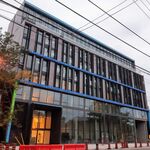1.Reduce the number of intermediate stations, to reduce capital and operating costs, offer faster journey times that will attract more new riders, and reduce disruption in surrounding communities. There should be a maximum of 10 stations on the 11-km underground section. The Avenue Road, Chaplin, and Oakwood stations could be omitted. Laird Drive station can be deferred, and built if and when a developer makes a substantial capital contribution to the station. Capital cost savings would be about $600 million, with a further savings of $1 million per year O&M costs per station.
2. Use high-floor cars with a top speed of 100km/h, such as the ALRT Mark 3 being supplied to Vancouver, instead of the 80 km/h low-floor cars TTC has specified. Besides saving staff costs, the higher speeds and faster journey will attract additional riders. Note that, as on the subway and existing RT, high-floor ALRT cars stop at high platform stations and will therefore be fully accessible.
3. Grade-separate the entire line, so trains will not affect road traffic and will offer faster journeys for transit riders. East of Laird Drive and west of Weston Road, Eglinton is a wide street with plenty of space to build an elevated line without harming the environment. This would add about $800 million to project costs, or perhaps $100 million per km, compared with the surface line that is currently planned. Road traffic disruption will be greatly reduced and there will be little or no permanent loss of road space.
4. Automate the trains. With an entirely grade-separated line, trains can be automated, with large
operating cost savings and the ability to offer more frequent off-peak services.
5.Build shorter platforms to reduce station costs. Current plans show 150-metre platforms, similar to the subway. Savings of about $10 million per underground station, or about $100 million could be captured by building 60-metre platforms, sufficient for all foreseeable traffic.




